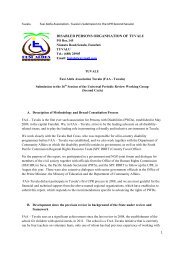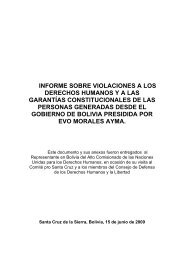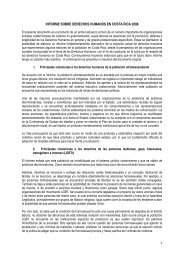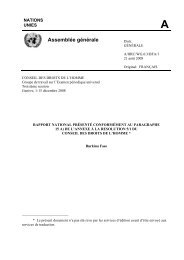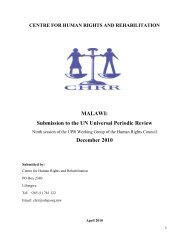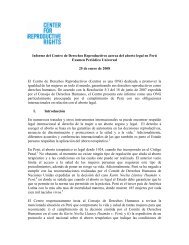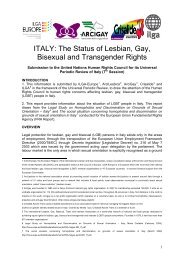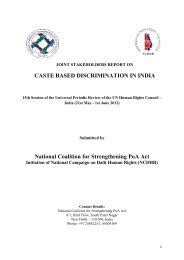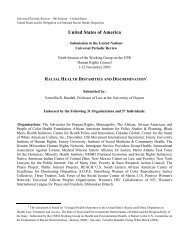Prison Needle Exchange: Lessons from a Comprehensive Review ...
Prison Needle Exchange: Lessons from a Comprehensive Review ...
Prison Needle Exchange: Lessons from a Comprehensive Review ...
You also want an ePaper? Increase the reach of your titles
YUMPU automatically turns print PDFs into web optimized ePapers that Google loves.
The first prison needle exchange program was introduced in July 1997 in Basauri prison,<br />
Bilbao, in the Basque region. This was followed by pilot programs in Pamplona prison<br />
(1998) and the Orense and Tenerif prisons (1999). In June 2001 the<br />
Directorate General for <strong>Prison</strong>s ordered that needle exchange programs<br />
be implemented in all prisons. By the end of 2001, syringe<br />
exchange was provided in 11 Spanish prisons. By the end of 2002<br />
the number of prisons providing needle exchange had grown to 27;<br />
and by the end of 2003, to 30. 151<br />
At present, the mandate to institute needle exchange programs<br />
exists for all 69 prisons under the jurisdiction of Spain’s Ministry of<br />
the Interior, with the exception of psychiatric prisons and one high-security-level prison.<br />
There is also a pilot needle exchange program established in one of the prisons under the<br />
jurisdiction of the government of Cataluña.<br />
By the end of 2003 the<br />
number of Spanish prisons<br />
providing needle exchange<br />
had grown to 30.<br />
HIV/AIDS, HCV, and IDU in Spain<br />
According to figures <strong>from</strong> UNAIDS and the WHO, there were approximately 130,000 adults<br />
(aged 15 to 49) living with HIV/AIDS in Spain at the end of 2001, and a prevalence rate of<br />
0.5%. 152 The HCV prevalence rate in the general community is approximately 3%. 153<br />
Although declining in recent years due to the wide implementation of harm-reduction programs<br />
such as methadone and needle exchange, the HIV prevalence rate among people who<br />
inject drugs continues to be high at 33.5% in 2000, down <strong>from</strong> 37.1% in 1996. As of June<br />
2001, the National AIDS Register had identified 39,681 cumulative cases of AIDS in Spain<br />
that were related to injection drug use, 65% of all AIDS cases identified up to that time. 154<br />
HIV/AIDS, HCV, and IDU in Spanish prisons<br />
Approximately half of Spanish prisoners have a history of illicit drug use, or are actively<br />
using drugs at the time of incarceration. The vast majority of prisoners seeking drug treatment<br />
during incarceration do so for heroin dependence (85%). However, there has been an<br />
increase in injection cocaine use in recent years. 155<br />
Rates of both HIV and HCV infection among Spanish prisoners are high. While prisoners<br />
represent only 0.01% of the total Spanish population, they account for 7% of AIDS diagnoses.<br />
156 Rates of infection are particularly high among those with a history of injection drug<br />
use. In 1989, the first cross-sectional HIV prevalence study found an HIV infection rate<br />
among prisoners of 32%. 157 Since that time, rigorous HIV prevention and harm-reduction initiatives<br />
in the community and in prisons have achieved significant results. In the early 1990s<br />
the HIV prevalence rate in prisons was approximately 23%. 158 In 2000 the HIV prevalence<br />
rate was reported to be 16.6%. 159 A 2002 joint report by the Ministry of the Interior and the<br />
Ministry of Health and Consumer Affairs estimated an HIV prevalence rate of 15% and an<br />
HCV prevalence rate of 40%. 160 Among incarcerated women, rates of HIV infection are particularly<br />
high: in 2001 the HIV prevalence rate among women prisoners was 38%. 161<br />
People who inject drugs comprise the majority of AIDS cases among Spanish prisoners. 162<br />
Approximately 90% of prisoners living with AIDS in Spain cite injection drug use as a risk<br />
factor. 163 Rates of HIV infection among prisoners with a history of injection drug use have<br />
been cited as high as 46.1%. 164<br />
Rates of HCV infection are even higher, particularly among people who inject drugs.<br />
According to a 1998 Penitentiary Health Study, 46.1% of prisoners were HCV infected. 165 In<br />
2002 the HCV infection rate was cited as being 40%. 166 Among prisoners with a history of<br />
30 <strong>Prison</strong> <strong>Needle</strong> <strong>Exchange</strong>: <strong>Lessons</strong> <strong>from</strong> a <strong>Comprehensive</strong> <strong>Review</strong> of International Evidence and Experience



